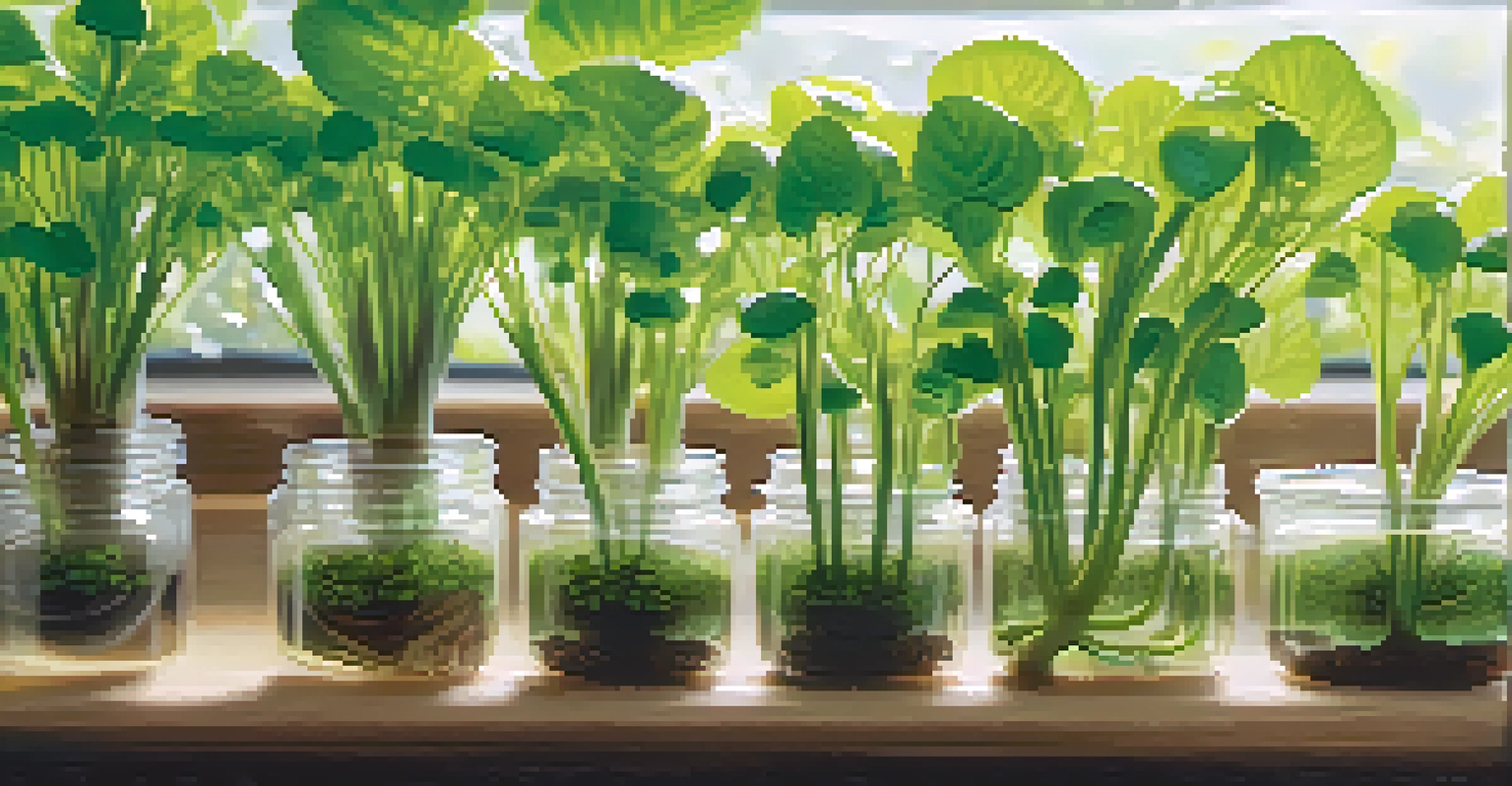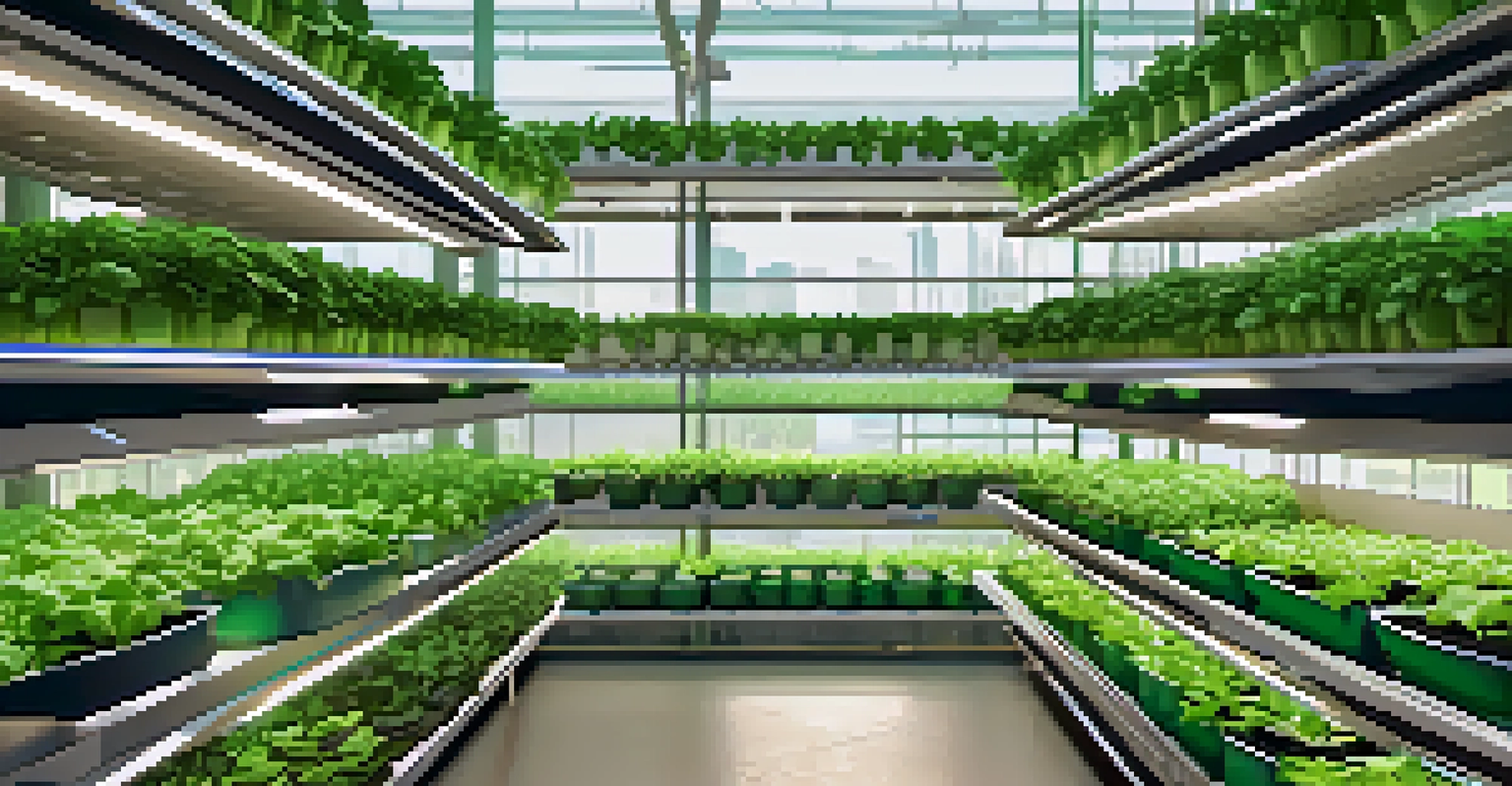Introduction to Hydroponics: The Future of Soil-less Farming

What is Hydroponics? A Brief Overview
Hydroponics is a method of growing plants without soil, using nutrient-rich water instead. This innovative technique allows for more efficient use of space and resources, making it a popular choice for urban farming. By delivering nutrients directly to the plant roots, hydroponics can promote faster growth and higher yields compared to traditional farming methods.
The future of food is not just about how we produce it, but also how we connect people to their food systems.
In hydroponic systems, plants are often supported by inert mediums like rock wool or clay pellets, which provide stability without any nutritional value. This method can be used to grow a variety of crops, from leafy greens to tomatoes, and even herbs. The versatility of hydroponics makes it an exciting area for both commercial growers and home gardening enthusiasts.
As the global population continues to rise, the demand for sustainable agricultural practices increases. Hydroponics offers a solution that minimizes land use and water consumption while maximizing productivity. By understanding the basics of hydroponics, we can appreciate its potential to reshape the future of food production.
The Benefits of Hydroponic Farming
One of the most significant advantages of hydroponics is its ability to produce crops in limited spaces. Urban areas, where traditional farming is often infeasible, can utilize hydroponic systems to grow fresh produce right where it's needed. This not only reduces transportation costs but also provides access to nutritious food in food deserts.

Furthermore, hydroponics uses significantly less water than conventional farming. In fact, studies show that hydroponic systems can use up to 90% less water due to the closed-loop design, where water is recirculated. This efficiency is crucial in areas facing water scarcity and adds to the sustainability of this farming method.
Efficient Space Utilization
Hydroponics allows for crop production in limited spaces, making it ideal for urban farming and food deserts.
Additionally, hydroponics can lead to reduced pesticide use and a lower risk of soil-borne diseases. Since the plants are grown in a controlled environment, growers can minimize their reliance on harmful chemicals, resulting in healthier produce. This aligns with the growing consumer demand for organic and sustainably grown food.
Common Hydroponic Systems Explained
There are several types of hydroponic systems, each with its unique advantages. Nutrient Film Technique (NFT) is one of the most popular methods, where a thin film of nutrient solution continuously flows over the plant roots. This allows for optimal nutrient absorption and oxygenation, promoting healthy plant growth.
Hydroponics is a way of growing food without soil, which means you can grow it anywhere, even in urban areas where space is limited.
Another common system is Deep Water Culture (DWC), where plants are suspended above a nutrient-rich water reservoir. Air stones provide oxygen to the roots, preventing rot and ensuring that the plants receive the necessary nutrients. DWC is particularly effective for growing fast-growing plants and is favored by many hydroponic enthusiasts.
Lastly, the Ebb and Flow system, also known as flood and drain, periodically floods the plant roots with nutrient solution before draining it back into the reservoir. This cycle ensures that the plants receive both nutrients and oxygen, creating a balanced growing environment. Understanding these systems can help growers choose the best option for their specific needs.
Getting Started with Hydroponics at Home
Starting a hydroponic garden at home is easier than you might think. Many beginners opt for small, countertop systems designed for growing herbs and leafy greens. These systems often come with everything you need to get started, including grow lights, nutrient solutions, and easy-to-follow instructions.
Before diving in, it's essential to select the right plants for your hydroponic setup. Leafy greens, such as lettuce and kale, are excellent choices for beginners due to their quick growth rates and lower nutrient requirements. As you gain experience, you can experiment with more challenging plants like strawberries or peppers.
Sustainable Water Use
This method uses up to 90% less water than traditional farming, promoting sustainability in water-scarce areas.
Maintaining a hydroponic garden requires attention to detail, particularly in monitoring pH levels and nutrient concentrations. Regular testing ensures that plants remain healthy and productive. With time and practice, you’ll find that hydroponic gardening can be a rewarding hobby that yields fresh produce right from your kitchen.
Challenges and Considerations in Hydroponics
While hydroponics offers numerous benefits, it also comes with its own set of challenges. One significant hurdle is the initial setup cost, which can be higher than traditional gardening methods. However, many enthusiasts consider this an investment, given the long-term savings on water and potential for higher yields.
Another challenge is the need for consistent monitoring and maintenance. Hydroponic systems require regular checks to ensure nutrient levels, pH balance, and environmental conditions are optimal. This level of involvement may not suit everyone, but for those who enjoy gardening, it can be a fulfilling process.
Lastly, pests and diseases can still pose a risk in hydroponics, despite reduced reliance on pesticides. Employing integrated pest management strategies and maintaining clean conditions can help minimize these risks. Understanding these challenges prepares growers to tackle them effectively and enjoy a fruitful hydroponic garden.
The Role of Technology in Hydroponics
Technology plays a vital role in the advancement of hydroponic farming. From automated systems that control lighting, temperature, and nutrient delivery to advanced monitoring tools that track plant health, technology can significantly enhance the efficiency of hydroponic setups. These innovations have made hydroponics more accessible and manageable for both commercial growers and hobbyists.
Smart hydroponics systems, equipped with sensors and IoT capabilities, allow growers to monitor conditions remotely. This means you can check on your plants from anywhere, ensuring they receive the care they need even when you’re not physically present. Such technology empowers growers to make informed decisions and optimize their processes.
Embracing Technology
Advancements in technology enhance hydroponic farming, making it more efficient and accessible for growers.
As technology continues to evolve, so does the potential for hydroponics to contribute to sustainable agriculture. Innovations like vertical farming and aquaponics combine hydroponic techniques with fish farming to create a symbiotic environment, reducing waste and increasing productivity. This integration of technology and farming practices paves the way for a more sustainable food future.
The Future of Hydroponics and Sustainable Farming
The future of hydroponics is bright, with the potential to revolutionize the way we think about food production. As urban areas expand and arable land diminishes, soil-less farming methods like hydroponics will become increasingly vital. This shift not only addresses food security but also promotes sustainable practices that benefit the environment.
Moreover, as consumers become more conscious of where their food comes from, hydroponics offers a way to produce fresh, locally grown produce. This trend is driving interest in community-supported agriculture and home gardening initiatives, creating a connection between consumers and their food sources.

In conclusion, hydroponics represents an exciting frontier in agriculture, blending technology, sustainability, and innovation. By embracing this soil-less farming technique, we can cultivate a resilient food system that meets the needs of future generations while protecting our planet.